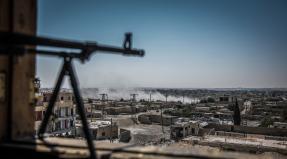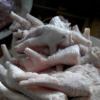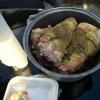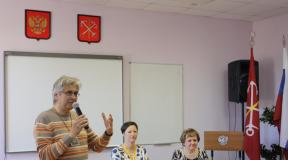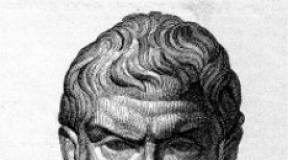On the platform is Konstantin Malygin. Palna - Mikhailovka Konstantin Malygin
Konstantin Alekseevich Malygin(November 20, 1905 - May 11, 1990) - Soviet military leader, Hero of the Soviet Union (1943), major general of tank forces, participant in the Great Patriotic War.
Biography
Konstantin Alekseevich Malygin was born on November 7 (20), 1905 in the village of Nikolskoye, now Uyarsky district, Krasnoyarsk Territory.
- 1923 - beginning of service in the Soviet Army.
- 1927 - graduated from the Krasnoyarsk Artillery School.
- 1927 - platoon commander of an artillery regiment of the 1st Kazan Rifle Division.
- 1927 - Member of the CPSU(b)/CPSU.
- 1928 - platoon commander in the artillery regiments of the 13th and 18th rifle corps of the Volga Military District.
- 1930 - assistant battery commander for political affairs, training platoon commander and artillery regiment battery commander in the same district.
- 1931 - platoon commander of an artillery division, from January 1933 - assistant commander of an artillery division of the Red Banner Infantry School of the Volga Military District (then Ulyanovsk Tank School).
- 1937 - graduated from the Leningrad Armored School (Military Academy of Mechanization and Motorization of the Red Army named after I.V. Stalin).
- 12.1937 - 03.1941 - Chief of Staff of the 38th Light Tank Brigade of the Kyiv Military District (from 07/26/1938 of the Kyiv Special Military District).
- 03.1941 - Chief of Staff of the 41st Tank Division of the 22nd Mechanized Corps (Kiev Special Military District).
- from June 1941 - on the fronts of the Great Patriotic War.
- 1941 - commander of the 28th Tank Brigade (16th, 30th and 39th Armies, Western and Kalinin Fronts). Defended Moscow and Rzhev.
- 1942-1943 - commander of armored and mechanized forces of the 3rd Shock Army (Kalinin Front). Liberated the city of Velikiye Luki (Pskov region).
- 1943 - “Major General of Tank Forces” (the title was awarded by the Decree of the Council of People's Commissars of the USSR of March 3, 1943).
- 1943 - commander of the Tambov military tank camp.
- 1943 - commander of the 9th mechanized corps, formed in Yasnaya Polyana, Tula region. In September 1943, the tank units entrusted to him crossed the Dnieper River near the village of Zarubintsy, Kanevsky district, Cherkasy region of Ukraine and heroically held the bridgehead.
- 1943 - awarded the title Hero of the Soviet Union (by Decree of the Presidium of the Supreme Soviet of the USSR of November 17, 1943).
- 1944 - Deputy Commander of the Kharkov Military Tank Camp for Combat Training.
- 1945 - commander of the 7th training division, and from October 1946 - 9th Guards Tank Division.
- 1948-1950 - senior lecturer at the Military Academy of Armored and Mechanized Forces named after I.V. Stalin.
- 1951 - graduated from the Higher Academic Courses at the Higher Military Academy named after K. E. Voroshilov.
- 1951 - commander of armored and mechanized forces of the Kyiv Military District.
- 1953-1956 - senior military adviser to the commander of the armored and mechanized forces of the People's Liberation Army of China.
- 1957 - head of a special faculty for the training of officers of the armies of people's democracies at the Military Academy of Armored Forces.
- 1961 - retired to the reserves with the rank of major general of tank forces.
Awards and recognition
- Hero of the Soviet Union, with the presentation of the Order of Lenin (No. 13696) and the Gold Star medal (No. 2096), November 17, 1943.
- Two Orders of Lenin.
- Two Orders of the Red Banner.
- Order of Suvorov, 2nd degree.
- Order of Kutuzov, 2nd degree.
- Order of the Patriotic War, 1st degree.
- Order of the Red Star.
- Medals.
- Honorary citizen of the city of Korostyshev, Zhytomyr region of Ukraine.
We met this pleasant man in all respects during the celebration of farewell to the Russian winter, which took place in the area of VNIIG and SPR. Back then, representatives of the stronger sex demonstrated their strength and skill in weight lifting competitions. After several performances, one of the participants showed a very high result. It seemed that no one would be able to surpass him. But then a middle-aged, dashing-looking man approached the projectile weighing 24 kilograms. The judge announced: “On the platform is railway transport worker Konstantin Malygin.” Working with the apparatus calmly, confidently, clearly, he lifted the weight over his head 70 (!) times, beating the previous best result. When he, as the winner, was awarded a certificate and a prize, he simply and calmly said: “I dedicate this victory to veterans in honor of the 70th anniversary of the Great Victory.” After this, the strongman fell into the arms of his wife Elena Viktorovna and daughters Anastasia and Dasha.
Konstantin Malygin was born in Yelets, Lipetsk region. After graduating from high school, he entered the railway school to study as an assistant driver. He served in the army in a group of Soviet troops in Germany at a space communications station with the rank of senior sergeant and as deputy platoon commander. After finishing his service, he entered the Lipetsk Polytechnic Institute to study at the Faculty of Industrial Heat and Power Engineering. It was here that I became seriously interested in kettlebell lifting. By the way, at that time the Yelets school of this sport was widely known. After some time, Konstantin transferred to the Moscow Correspondence Institute of Transport Engineers. After graduating in 1992, he began his career at the Kaluga Mechanical Plant as an engineer. While studying and working, he never parted with his favorite weight, which always remained his faithful companion.
In 1994, fate brought Konstantin to our city. He was hired as an electromechanic for safety devices at the Michurinsk locomotive depot. Then he worked as an engineer in the technical department, was an employee of the labor protection and industrial safety department, head of the department of the directorate for passenger services in the suburban direction, chief engineer of the Michurinsk locomotive depot, and chief engineer of the Suburban Additional Operations Department. Currently, Konstantin Nikolaevich is the head of the Tambov section of the South-Eastern Directorate of Passenger Facilities. His work involves constant travel, the purpose of which is to improve the condition of the railway economy.
Once, at a festival for railway workers of the Michurinsky branch of the Southern Eastern Railway, held according to tradition at the Volna recreation center, Konstantin Malygin in a weight lifting competition showed a result that has not yet been surpassed by anyone, lifting a weight weighing 24 kilograms with a jerk 80 (!) times. After this, spot instructor N.S. Belousov began regularly sending him to various kettlebell lifting competitions. So Konstantin Malygin became the champion of the South-Eastern Railway in kettlebell lifting, performing in the weight category of over 90 kilograms. His best results: clean and jerk - 85 times, snatch - 80 times. And sometimes, during training, he lifts the weight with a jerk and jerk a hundred times! And it is no coincidence that he is a multiple winner of prestigious competitions held in Voronezh, Liski, Yelets, Tambov, and Ryazan. Today, in the ranking of the strongest weightlifters of the South-Eastern Railway, he ranks second, second only to six-time world champion Andrei Kravtsov.
Konstantin Malygin is proud of his acquaintance with such celebrities as Igor Bogdanov, Boris Gridnev, listed in the Guinness Book of Records as the record holder for the number of weight lifts in one approach, Vladimir Sineglazov, who owns unique weights weighing 85 and 150 kilograms, cast to special order in Lipetsk metallurgical plant.
At K.N. Malygin has dozens of diplomas, certificates, cups, medals, a huge number of prizes won at numerous competitions. N.S. Belousov described him this way: “A real man, a hard worker, a professional in his field, an excellent family man. It’s not for nothing that his photograph adorns the South Eastern Railway Board of Honor.” At K.N. Malygina is a wonderful family. His wife Elena Viktorovna works as an engineer for labor standards in the power supply distance, the eldest daughter Anastasia graduated from the Moscow State Regional University with a degree in linguist-translator, the youngest Dashenka entered the fifth grade of school No. 15, dances and wants to become a skier.
K.N. Malygin leads a healthy lifestyle. He achieved a lot in life thanks to weight lifting. At the end of the conversation with this amazing man, a real Russian hero, we asked about his plans for the future. “I will continue to do what I love,” he answered simply.
20.11.1905 - 11.05.1990
Hero of the Soviet Union
Malygin Konstantin Alekseevich - commander of the 9th mechanized corps (3rd Guards Tank Army, Voronezh Front), major general of tank forces.
Born on November 7 (20), 1905 in the village of Nikolskoye, Uyarsk volost, Kansky district, Yenisei province (now Uyarsky district, Krasnoyarsk Territory). Russian. In 1917 he graduated from the 3rd grade of school in his native village.
In the army since October 1923. In 1927 he graduated from the Krasnoyarsk Artillery School. He served in the artillery as a platoon commander, assistant commander and battery commander (in the Volga Military District). In October 1931 - November 1933 - platoon commander and assistant commander of the artillery division of the Ulyanovsk rifle and artillery (from April 1932 - armored) school.
In 1937 he graduated from the Military Academy of Mechanization and Motorization. He served in the tank forces as chief of staff of a tank brigade, and from March 1941 - chief of staff of the 41st Tank Division (in the Kiev Special Military District).
Participant of the Great Patriotic War: in June-September 1941 - chief of staff of the 41st Tank Division (Southwestern Front). Participated in an oncoming tank battle near the city of Lutsk (Ukraine) and the defense of Kyiv.
In September 1941 - December 1942 - commander of the 28th Tank Brigade. He fought on the Western (October-December 1941) and Kalinin (March-December 1942) fronts. Participated in the Battle of Moscow and the Rzhev-Vyazemsk operation. On August 10, 1942 he was shell-shocked. In December 1942 - February 1943 - commander of armored and mechanized forces of the 3rd Shock Army (Kalinin Front). Participated in the Velikiye Luki operation.
In February-July 1943 - commander of the Tambov military tank camp; was engaged in the formation and training of tank and mechanized units and formations for the active army.
In August 1943 - April 1944 - commander of the 9th Mechanized Corps. He fought on the Voronezh (September-October 1943) and 1st Ukrainian (October 1943 - April 1944) fronts. Participated in the Sumy-Priluki operation, the battle for the Dnieper, the Kyiv offensive and defensive, Zhitomir-Berdichev and Proskurov-Chernovtsy operations.
He especially distinguished himself during the crossing of the Dnieper. On the night of September 22, 1943, the advanced units of the corps under his command crossed the river in the area of the village of Zarubintsy (now does not exist, flooded by the waters of the Kaniv reservoir, the territory of the Cherkasy region, Ukraine) and, despite massive enemy bombing by aviation and artillery shelling of the area, ensured On September 27, 1943, tank units of the corps were transferred to the right bank of the Dnieper. Then, until October 15, 1943, he led the battles of the corps entrusted to him to expand the Bukrinsky bridgehead in the areas of the villages of Zarubintsy, Lukovitsa and Grigorovka (Kanevsky district of the Cherkasy region), being at the command and observation posts of the brigades.
For skillful command of the corps and courage and heroism shown in battles with the Nazi invaders, by Decree of the Presidium of the Supreme Soviet of the USSR of November 17, 1943, to Major General of Tank Forces Malygin Konstantin Alekseevich awarded the title of Hero of the Soviet Union with the Order of Lenin and the Gold Star medal.
In April 1944 - July 1945 - deputy commander of the Kharkov military tank camp for combat training.
In July 1945 - September 1946 - commander of the 7th training tank brigade. In October 1946 - December 1948 - commander of the 9th Guards Tank Division (in the Group of Soviet Forces in Germany).
In 1948-1950 – senior lecturer at the department of tactics of higher formations of the Military Academy of Armored and Mechanized Forces. In 1951 he graduated from the Higher Academic Courses at the Higher Military Academy (Military Academy of the General Staff). In July 1951 - July 1953 - commander of armored and mechanized forces of the Kyiv Military District.
In July 1953 - February 1957 he was on a business trip abroad to China as a senior military adviser to the commander of the armored and mechanized forces of the People's Liberation Army of China.
Since May 1957 - head of a special faculty for the training of officers of the armies of people's democracies at the Military Academy of Armored Forces. Since January 1961, Major General of Tank Forces K.A. Malygin has been in reserve.
Major General of Tank Forces (1943; Major General - 1984). Awarded 2 Orders of Lenin (11/17/1943; 06/20/1949), 2 Orders of the Red Banner (11/3/1944; 04/30/1954), Orders of Suvorov 2nd degree (01/10/1944), Orders of Kutuzov 2nd degree (01/31/1943) , Patriotic War 1st degree (03/11/1985), Red Star (1941), medals, foreign awards.
Honorary citizen of the city of Korostyshev (Zhytomyr region, Ukraine).
In Moscow, a memorial plaque was installed on the house in which he lived.
Military ranks:
Major (12/22/1937)
Lieutenant Colonel (10.10.1940)
Colonel (1941)
Major General of Tank Forces (02/07/1943)
Major General (04/26/1984)
|
Biography provided |
Malygin, Konstantin Alekseevich. In the center of the battle formation. M.: Voenizdat, 1986
Chapter "In the Forty-First Thunderstorm" (fragment)
K.A. Malygin (1905 - 1990), photograph taken in 1945.
From October 1941 to November 1942 he was commander of the 28th Tank Brigade
Fighting was already taking place on the approaches to Mozhaisk, and our brigade, which was not yet trained and armed, was transferred to a place located not far from Vladimir. Weapons and tanks began to arrive there, and a marching motorized rifle battalion also arrived. The personnel took the oath, and people were solemnly handed weapons. Combat training began. Day and night, machine guns and machine guns crackled at the shooting range, tank guns roared, mines and hand grenades exploded. The tankers were tensely preparing to meet the enemy.
In mid-October, I was summoned to Moscow by the commander of the armored and mechanized forces of the Red Army, Lieutenant General of the Tank Forces Ya. N. Fedorenko.
“It’s tough, brother, things are at the front,” he said, without listening to my report of arrival. - The German is pressing... Many institutions have been evacuated to the east. We are sending your brigade to the front. There will be an order. I know that we are not quite ready, but... Tomorrow we will send trains for loading. How are you doing?
- T-34 tanks - eleven, KV-1 - five, light T-60 - sixteen. There is one 76-mm cannon, six mortars, four anti-aircraft, 37-mm, and eight 20-mm mortars. That's all the striking force.
- Not much, but what should I do?
Having made a short parting word, Ya. N. Fedorenko released me.
And on October 22, the brigade, consisting of the 28th tank and 28th motorized rifle battalions, an anti-aircraft division, reconnaissance, repair, motor transport companies and control, was loaded into two echelons and sent to the Western Front.
We received orders to take up defensive positions in the Kubinka station area.
Artillery fire could be heard clearly, and the chatter of machine guns was barely perceptible. Having captured the cities of Ruza and Gzhatsk, the enemy was rushing towards Moscow. The front troops, putting up stubborn resistance, retreated.
We carried out reconnaissance, positioned tanks and positioned infantry units. The anti-aircraft division took up firing positions. Our and enemy planes flew along the highway at low altitudes. One Messerschmitt, while pursuing our attack aircraft returning from a mission, ran into fire from an anti-aircraft battalion and crashed into a clearing. The pilot survived and was captured by soldiers of the motorized battalion. He was sent to front headquarters.
At 10 o'clock on October 25, we received an order to transfer the brigade to Lieutenant General K.K. Rokossovsky, commander of the 16th Army, which fought heavy battles for Volokolamsk. By 24 o'clock on October 25, the formation should have arrived there. The route was determined: Golitsyno, Zvenigorod, Novopetrovskoye, Volokolamsk.
Having studied the order, we sent reconnaissance along the specified route in order to check the passability of the roads. The reconnaissance soon returned. It turned out that only tracked vehicles could travel along the route. I decided to lead the brigade to Volokolamsk in two columns. The tank one was headed by my deputy, Lieutenant Colonel I.D. Beloglazov, and I drove the wheeled vehicles through Moscow.
When the head of the column reached the fork in the Leningrad and Volokolamsk highways, the powerful but calm voice of Yuri Levitan sounded through the loudspeakers. An air raid alert was announced. Hundreds of searchlight beams cut through the sky. The anti-aircraft guns opened barrage fire. The searchlight beam caught an enemy plane, was following it, and the bright paths of the shells went in the same direction. The vulture darted, dived, slid on its wing, and tried to dive into the darkness that would save it. But the searchlights worked accurately, and a minute later a torch flashed in the black sky - there was one less robber.
At about 10 p.m. the convoy entered Novopetrovskoye. The silence of the night was broken only by the noise of engines, and the darkness was broken by thin rays passing through the small slits of camouflaged headlights. At the building of the district executive committee, about a hundred militiamen armed with rifles were crowded under the command of a policeman with a revolver, saber and binoculars, sitting on a tall white horse. Our reconnaissance armored car stood nearby. The crew reported that enemy tanks had occupied the village of Skirmanovo to the south of us, which is 12 kilometers from here.
“On the way to Rozhdestveno,” the scout reported, “enemy vehicles got stuck in the mud.” They just have to cross two kilometers of country road, and further from Rozhdestveno there is a paved road. Apart from dirt, nothing resists the enemy.
“If you don’t stop them,” the policeman said, “then in the morning they will be here, and there will be Moscow...
- Well, we won’t let that happen. The commander did not arrive with his bare hands... - they started talking around.
I unfolded the map and illuminated it with a flashlight. The situation was not in our favor. True, if German tanks go to Novopetrovskoye, we will meet them. And if they choose another route - through Onufrievo to Istra or through Nikolskoye to Rumyantsevo station, then... Our troops are neither in Onufrievo nor in Nikolskoye.
“Suvorov taught: if you are ordered to go to the right, but should go to the left, then go left,” I muttered, but the commissar heard and weightily remarked:
- Suvorov taught, but go figure it out as it should!
- Do you think that we can continue to carry out the order and give up on Skirmanovo: it’s not our business, they say? - I asked Gulyaev.
- Well, what does your commander’s instinct tell you? - he answered the question with a question.
- But here’s what: we need to act according to the current situation. Turn south and block the Germans’ path to Moscow.
- That's right, commander! - Vasily Georgievich warmly approved my decision.
I gave the order: a motorized rifle battalion with one cannon should take up defensive positions in Onufrievo and cover the road to Istra, a company of light tanks should be placed on the edge of the forest near Nikolskoye, crossing the path to Rumyantsevo, a tank battalion and a detachment of militia should be withdrawn to Rozhdestveno, which is on the way from Skirmanovo. If the Germans go to Novopetrovskoye, we must meet them with fire from an ambush.
He immediately reported the decision to Lieutenant General K.K. Rokossovsky.
The units began to carry out the order. I entered the brigade headquarters, which was located in the building of the district executive committee. Literally after me, the chief of staff, Major V.N. Buslaev, appeared in the office with two girls. It turns out that they came from Skirmanovo. They said that they saw tanks, cars, and soldiers. The cars allegedly got stuck going up the hill. A very cool hill.
-Are there many tanks in the village? - I asked.
- Lots and lots! - the girls answered in one voice.
- How much? Five, ten, one hundred?
The girls were silent and looked at each other.
- We don’t know, we didn’t count, but it’s a lot.
- Could you return to Skirmanovo and find out where and how many tanks are there?
The dark-eyed, shorter one said:
- I will go.
- Fine. What's your name, girl?
- Rose.
“Enter the village from the same side as you left, from the Gorki side,” I said. - Be careful. It is important not to be noticed. I’m expecting you at Rozhdestveno at six o’clock in the morning. It's clear?
- It's clear. But I won’t have time by this time. It's far away...
- And we’ll give you a lift to the end of the highway by car. It's very close there.
“Then I’ll have time,” she said and quickly stood up, straightening the scarf on her head. Buslaev saw her off. I called Private Zakhar Rakhmatulin and ordered him to get into Skirmanovo, count the tanks in the eastern part of the village to the road to Rozhdestveno and find out at least their approximate location.
For about three minutes Rakhmatulin sat over the map, studying the area and the routes of penetration into Skirmanovo, and stood up and said:
- I'll do everything right. Please give me a lift to this barn,” and showed it on the map.
- Tell the company commander to take you there on a motorcycle and wait for your return. I will meet you at Rozhdestveno at six in the morning.
At about five o'clock in the morning our liaison officer arrived from army headquarters and reported the situation. The front line ran along the Lama River, excluding Volokolamsk, abandoned by our troops yesterday evening, then along the Ozerna River to the south. The 78th Siberian Rifle Division should approach the area of the village of Onufrievo. In short, there were no troops from the Ozerna bend to Lake Trostenskoye. There is a gap in the front here.
General K.K. Rokossovsky approved my decision.
Having given the necessary orders, I went to the headquarters of the tank battalion located in Rozhdestveno. Rosa was already waiting for me; she counted 15 tanks, but was not sure that she had found all of them. At night it was difficult to distinguish where the tank was and where the car was, but I was afraid to get close, the sentries called out.
I thanked the girl and asked:
- Rosa, would you like to stay with us as a nurse in the medical platoon?
“I agree,” Rose answered. - I am an orphan, I lived with my grandmother.
She was enrolled in the medical platoon. Rosa walked with the brigade throughout its long and difficult journey until the last day of the war. Now Roza Martynovna Melnikova (by her husband Baev) lives in Novgorod, raised two sons: one is a military man, the other is a sculptor.
Rakhmatulin also returned. He counted 18 tanks and was also not sure that he had found everything. The houses are filled with soldiers, they don't wear disguises.
- You have completed the first task, Comrade Rakhmatulin. I praise you. Go, rest,” I said and firmly shook the scout’s hand.
Palna - Mikhailovskaya Secondary School
bore the name of Hero of the USSR
Malygina K.A.
Paying tribute to the memory of the hero, this page was created.
MALYGIN Konstantin Alekseevich born in 1905 in the village of Nikolskoye, Uyarsky district.
Called up in 1923. After graduating from artillery school, he served as a platoon, battery, and division commander. In 1937 he graduated from the Leningrad Armored School. Participated in the defense of Moscow, Leningrad, Velikiye Luki, Rzhev, and the liberation of Kyiv.

Guard Major General, commander of the 9th Mechanized Corps Konstantin Malygin from September 22 to 27, 1943, despite massive air bombing and artillery shelling of the area, ensured the timely transfer of tank units to the right bank of the Dnieper in the Zarubentsy area. From September 27 to October 15, he led the corps’ battles to expand the bridgehead in the areas of Zarubentsy, Lukovitsy, and Grigoryevka, being at the command and observation posts of the brigades.
He showed particular valor on September 29 in the decisive battles to hold and expand the bridgehead, drawing soldiers and officers to carry out the combat mission. As a result, the conquered lines were retained.
The title of Hero of the Soviet Union was awarded to Konstantin Alekseevich Malygin on November 17, 1943.
MALYGIN Konstantin Alekseevich (1905-1990)
Major General Tank. troops (1943), Hero of the Soviet Union. Union (1943). Member of the All-Union Communist Party (Bolsheviks) since 1927. In the Red Army since 1923. Graduated from art school in (1927), Military Academy. mechanization and motorization (1937), courses at Acad. General Staff (1951). Since 1927 in command positions in artillery. Since 1937 beginning tank headquarters brigade, tank. divisions. During the war, early tank headquarters division, tank commander. brigade, in 1942-43 commander of the armored and mechanized forces (BTiMV) of the army. In 1943-44 commander of the mechanized corps. Since 1944 deputy Commander of the Kharkov Military District. After the war he commanded a tank. divisions. In 1948-50, teacher at the Military Academy. armored and mechanized forces. In 1951-53, commander of the BTiMV of the Kyiv Military District. In 1953-56 military adviser in China. Since 1957 Faculty of the Military Academy of Armored Forces. In reserve since 1961.

Memoirs
Malygin Konstantin Alekseevich
In the center of the battle formation
Website “Military Literature”: militera.lib.ru
Edition: Malygin K. A. In the center of the battle formation. - M.: Military Publishing House, 1986.
Book on the website: http://militera.lib.ru/memo/russian/malygin_ka/index.html
Illustrations: http://militera.lib.ru/memo/russian/malygin_ka/ill.html
OCR, editing: Andrey Myatishkin ( [email protected])
Additional processing: Hoaxer ( [email protected])
This is how the pages are marked, number precedes.
(1) Links to notes are marked this way.
Malygin K. A. In the center of the battle formation. - M.: Voenizdat, 1986. - 205 p. - (War memoirs). / Literary record of Yu. D. Kokorin. Circulation 65,000 copies.
Publisher's abstract:
The author is an experienced front-line soldier, at the final stage of the Great Patriotic War, the commander of the 9th Kiev-Zhitomir Mechanized Corps, Hero of the Soviet Union, tells about the first period of the war, heavy battles on the fields of the Moscow region, Upper Volga region, Ukraine, about the courage and dedication of the soldiers they showed in fight against fascist invaders.
In the forty-first thunderstorm
Fire miles
Dnieper steeps
In Right Bank Ukraine
Let's go to the border
Notes
List of illustrations

28th Tank Brigade
Brigade command staff
brigade commanders:
Colonel Malygin Konstantin Alekseevich [from 09/28/1941 to 12/07/1942];
Lieutenant Colonel Kovalev Efim Maksimovich [from 12/08/1942 to 02/07/1943]
deputy brigade commander for combat units:
Lieutenant Colonel Beloglazov Ivan Dmitrievich [October 1941]
military commissar of the brigade, from the end of 1942 - deputy brigade commander for political affairs:
Regimental Commissar Gulyaev Vasily Georgievich [October 1941]
Katkov Georgy Georgievich.
Deputy brigade commander for technical matters:
Captain N.P. Shalaginov [died October 30, 1941]
military engineer 3rd rank Anatoly Petrovich Schwebig [until September 1942]
Major? Zholobov Mikhail Yakovlevich.
brigade chiefs of staff:
Major Buslaev Vasily Nikitovich [October 1941]
Colonel Trubitsyn Petr Ivanovich [died August 16, 1942]
Major Kovalev Efim Maksimovich
Assistant Chief of Staff of the Brigade:
head of the political department:
Art. battalion commissar Georgy Georgievich Katkov [October 1941]
History of formation
The 28th separate tank brigade was formed on September 28, 1941 in Naro-Fominsk and Kosterevo village (Moscow region). The brigade was formed according to states No. 010/75 - 010/83 and 010/87 dated September 13, 1941. List of units included in the tank brigade:
Brigade management - 54 people.
Control company - 175 people.
Reconnaissance company - 107 people.
28th Tank Regiment - 422 people.
1st Tank Battalion
2nd Tank Battalion
Motorized rifle and machine gun battalion - 422 people.
Anti-aircraft division
Repair and restoration company - 91 people.
Motor transport company - 62 people.
Medical platoon - 28 people.
On October 22, 1941, the brigade was sent to the front. Took up defensive positions in the area of the station. Cuban. On October 25, 1941, the brigade was reassigned to the commander of the 16th Army. From October 26, 1941 in the battles for Skirmanovo. Suffered significant losses. From November 12, 1941, together with the 4th and 27th Tank Brigades. On November 16, 1941, it was subordinated to the 3rd KK.
In the active army:
from 10/24/1941 to 12/21/1941
from 03/23/1942 to 02/07/1943
Composed of: 16th A (from 10.25.1941), 30th A, 39th A (II), 3rd BF
By order of NKO No. 58 of February 7, 1943, the brigade was reorganized into the 28th Guards Tank Brigade.
Tank snipers
The crew of the T-34 tank, company commander Captain Stepanyan, destroyed 5 enemy tanks, an anti-tank gun, a tractor, 2 vehicles and up to 40 enemy infantry.
crew of the T-34 tank, political instructor Barmin - destroyed 8 enemy tanks
crew of the T-34 Oshkali tank - 7 tanks and 7 anti-tank guns
Combat and numerical strength
on 10/25/1941 (16th A, Polar Fleet) - 31 tanks, including: 4 KV-1, 11 T-34, 16 T-30. Soviet light tanks T-30, T-40 and T-40S.
on 10/28/1941 (16th A, Polar Fleet) - 31 tanks, including: 4 KV-1, 11 T-34, 16 T-30. Battle for Moscow. With. 40; The Red Army in victories and defeats.
as of 11/16/1941 (16th A, Polar Fleet), there are 15 tanks: 1 KV, 4 T-34, 10 light. Battle for Moscow. With. 45; The Red Army in victories and defeats.
================================
Malygin K.A. Hero of the USSR Moscow, Tankovy proezd 3, Memorial plaque.
================================
Buried at Vvedenskoye Cemetery, Moscow, Plot No. 4


